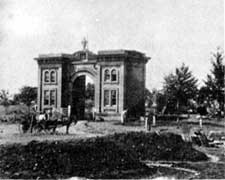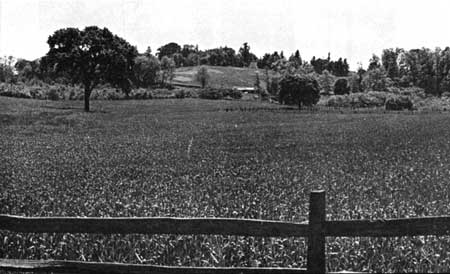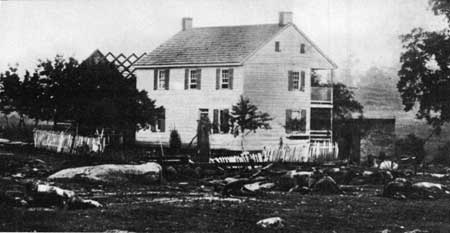|
GETTYSBURG National Military Park |
 |
 Lunettes, or artillery defense works, on the crest of East Cemetery Hill. The entrance gateway to the public cemetery, which is still in use, appears in the background on the Baltimore Pike. Brady photograph. |
 Jennie Wade House, located on Baltimore street between the battle lines. Jennie Wade, the only civilian killed during the battle, was accidentally struck by a bullet which passed through a door of the house. |
The Second Day
PRELIMINARY MOVEMENTS AND PLANS. The small college town of Gettysburg, with 2,400 residents at the time of the battle, lay in the heart of a fertile country, surrounded by broad acres of crops and pastures. Substantial houses of industrious Pennsylvania farmers dotted the countryside. South of the town and hardly more than a musket shot from the houses on its outer edge, Cemetery Hill rose somewhat abruptly from the lower ground. Extending southward from the hill for nearly 2 miles was a long roll of land called Cemetery Ridge. At its southern extremity a sharp incline terminated in the wooded crest of Little Round Top and a half mile beyond was the sugar-loaf peak of Big Round Top, the highest point in the vicinity of Gettysburg. Paralleling Cemetery Ridge, at an average distance of two-thirds of a mile to the west, lay Seminary Ridge, which derived its name from the Lutheran Seminary that stood upon its crest a half mile west of Gettysburg. In 1863, 10 roads radiated from Gettysburg, the one leading to Emmitsburg extending diagonally across the valley between Seminary and Cemetery Ridges.
By noon of July 2, the powerful forces of Meade and Lee were at hand, and battle on a tremendous scale was imminent. That part of the Union line extending from Cemetery Hill to Little Round Top was strongly held. Late in the forenoon, Sickles, commanding the Third Corps which lay north of Little Round Top, sent Berdan's sharpshooters and some of the men of the 3rd Maine Regiment forward from the Emmitsburg Road to Pitzer's Woods, a half mile to the west. As they reached the woods, a strong Confederate force fired upon them, and they hurriedly retired to inform their commander. To Sickles, the extension of the Confederate line southward meant that his left flank was endangered. He at once began moving forward to the advantageous high ground at the Peach Orchard, and by 3:30 p. m. his battle front extended from Devil's Den northwestward to the Orchard and northward on the Emmitsburg Road. In this forward movement, the strong position on the crest of Little Round Top was left unoccupied. This was the situation when Meade finally turned his attention from his right flank at Culp's Hill and Spangler's Spring—the cause of his great concern throughout the forenoon—to review Sickles' line.

East Cemetery Hill, the objective of the Confederate charge on the
evening of July 2.
Lee planned to attack, despite the advice of Longstreet who continually urged defensive battle. On July 2, Longstreet recommended that Lee swing around the Union left at Little Round Top, select a good position, and await attack. Lee observed that while the Union position was strong if held in sufficient numbers to utilize the advantage of interior lines, it presented grave difficulties to a weak defending force. A secure lodgment on the shank of the hook might render it possible to sever the Union Army and to deal with each unit separately. Not all of Meade's force had reached the field, and Lee thought he had the opportunity of destroying his adversary in the process of concentration. He resolved to send Longstreet against the Federal left flank which he believed was then on lower Cemetery Ridge, while Ewell was to storm Cemetery Hill and Culp's Hill.

Trostle farmhouse. Here the 9th Massachusetts battery, taking
position in the yard, lost 80 out of 88 horses during the battle of July
2.
Brady photograph.

|

|
|
Last Modified: Mon, Mar 4 2002 10:00:00 pm PDT |


